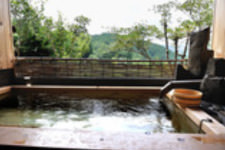Culture
Japanese bath -Onsen-

Japanese bath, bath etiquette and Public bath in Japan
After returning from the trip abroad, the first thing most Japanese want to do is eat a good meal. and take a long bath. Japanese are fond of soaking in the tub. According to one survey, 88 % of Japanese said they like taking baths In a Japanese bath, an extra deep tub is filled to the top with very hot water, in which you sit submerged up to the neck. Most people spend about half an hour in the bath every night.most children take baths, with their father or mother until they are in the upper grade of elementary school. The family tub is an important place for parent-child communication.
Why did Japanese developed its particular style of bathing? One answer might be the climate. Japan's summer is hot and humbled, and it's waters are cold. hot baths wash the body's sweat off in the summer and warm the body up inn the winter. Another answer might be Japan's volcanoes, Japan is famous for its number of volcanoes, many of which are still active, In many places, hot water bubbles up from underground. These hot spring, and the presence of many fast flowing rivers with clean water, have influence the development of Japan' Bath culture.
Japanese use their baths not only to get clean but to maintain their health by warming themselves up and stimulating their circulation. Because the body is washed outside the bath, the bath water stays clean and deeply refreshing. In the Hot spring or the public bath, everybody baths same water, creating an unclothed companionship that facilitates amiable communication. In the bath, you can relax, recover from exhaustion,rid yourself of your stress. No wonder Japanese love their baths.
Bath Etiquette
We introduce the standard approach to taking a Japanese bath, In the Japanese "bathroom" a separated room from the toilet, the bath is sunk halfway into the floor. because the bath water is only used for soaking(not for washing) all member of family take turn using it. You wash in the area outside of the bath, do not enter the bath unrinsed or wash yourself in the bath water. Towels in the bath is also No.
*
Rinse your body off outside the tub.Use a washbowl to scoop hot water out of the tub to rinse yourself with.
*
Get in the bath, the water temperature should be between 38-42 degree. and the water should be deep enough that an adult can sit submerged up to the neck. Fifty years ago, tubs were made of wood, but nowadays, they are made of tile, plastic, or stainless steel.
*
Get out of the bath, Sit down and wash yourself thoroughly. You can wash your hair too, Use the shower or water from bath to clean any remaining soap or shampoo from the floor, which is made of tile or plastic. You may use as much as water as you like.
*
Get back into the bath and warm yourself up thoroughly. When you get out, don't pull the plug. Replace the cover over the bath so that the water does not get cold for next person.
Public bath
Large public bath are fixtures in many urban neighborhoods. Their existence is recorded as far bake as the mid-eight century, when they began as free bath facilities for the community of people in resistance at large temples.
Men and women at this time used the same bath. In the Edo period, about 600 public baths provided washing facilities and places for socialized for the more than one million people who lived in the city of Edo. Public baths are an essential part of most people's lived until the 1970 that time most household had their own baths as did many more apartment.
The number of public baths nation wide declined from more than 23,000 in 1964 to fewer than 10,000 in 1991 Modern public baths have separate facilities for men and women. Admittance is about 360 yen.
Some of the more up-to-date places also have a sauna and other health facilities. Japan is One of the few places in the world where groups of people baths together. Many people with baths in their own homes still visit the "Sento"in search of a place to socialize with their neighbors.
- :: Back to Japanese Culture
Culture
- Travel tips
- History
- Culture
Food
Japanese Culture
- Tea Ceremony
- Flower arrangement
-Ikebana- - Hinomaru
(National flag of Japan) - National flower of Japan
- National bird of japan
- Kabuki
- No & Kyogen
- Japanese Tanka
- Ukiyoe
Wood Block Prints - Origine of
Japanese People - Japanese language
- Onsen
- Hanami (Flower viewing)
- Japanese festival
- Housing in Japan
- Manga
- Kodomonohi
(Children's Day)
